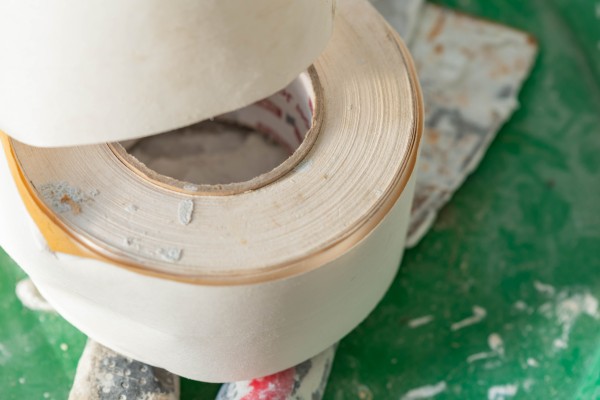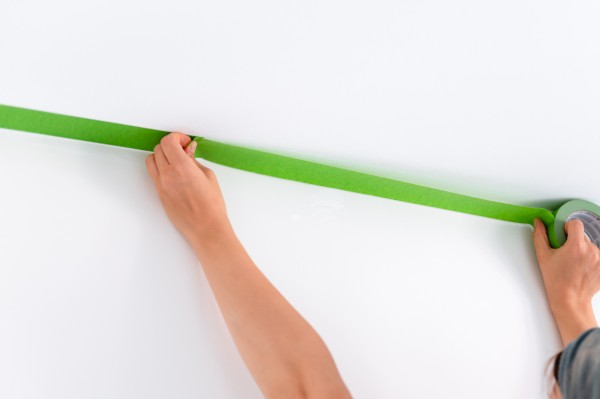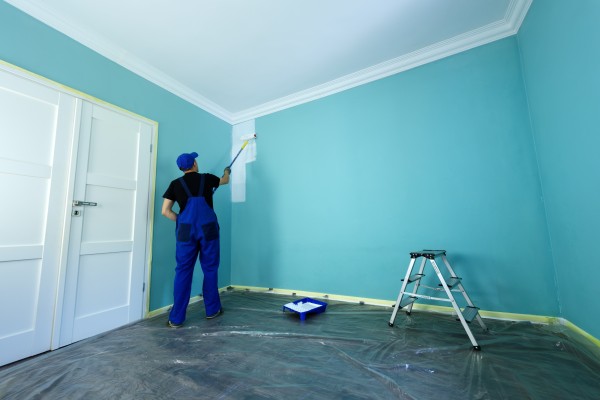Kite blog
What is the Best Tape for Painting?
Achieving a clean, professional finish starts with choosing the best tape for painting. The right option can make all the difference between a crisp edge and unwanted paint bleed. With so many varieties available, from traditional masking tape to specialist painter’s tape, decorators in the painting industry need to know which type of tape best suits their job.
Each kind of tape has its strengths. Standard masking tape works well for everyday use, while low tack masking tape offers protection for delicate surfaces and fresh paint. Premium options like Frog Tape and blue painter’s tape deliver sharp lines and reliable performance across multi surface applications.
Beyond surface protection, choosing the right tape ensures clean removal, strong adhesive quality, and minimal residue once the job is done. This guide explores the main types of painting tapes, explains when to use them, and shares practical tips to help professionals get the best results on their next painting project.
Contents
- What is the Best Tape for Painting?
- Masking Tape
- Delicate Surfaces
- Low Tack Masking Tape
- Frog Tape
- Painter’s Tape
- Fresh Paint
- How Kite Packaging Can Help
Masking Tape

Among the most widely used tools in the painting industry, masking tape plays a vital role in achieving tidy, professional finishes. Whether you’re working on walls, wood trim, or delicate interior details, the right masking tape helps prevent paint bleed and keeps edges looking sharp. It’s a simple yet essential product that supports accuracy and efficiency in every painting job.
What is Masking Tape?
Masking tape is a pressure-sensitive adhesive tape made with a crepe paper backing. It’s designed for easy tear, quick application, and clean removal once the job is finished. Used daily in the painting industry, it’s a go-to product for achieving neat, controlled results on a variety of surfaces.
Professionals use masking tape for everything from edging walls and wood trim to protecting skirting boards and metal fittings. Its flexibility and reliable adhesive make it suitable for both detailed finishing and larger decorating projects.
Where and How to Use It
Masking tape helps protect surfaces during decorating and renovation work, keeping paint exactly where it should be.
Common uses include:
- Edging and cutting in on walls and ceilings
- Guarding wood and glass from overspray
- Marking straight lines for two-tone or feature designs
It’s a simple yet effective way to maintain precision and reduce the need for touch-ups once painting is complete.
Benefits
Good quality masking tape offers several advantages:
- Creates a solid barrier that stops paint bleed
- Peels away cleanly without residue or peeling
- Available in different strengths, including:
- Medium adhesion for smooth, interior use
- High adhesion for textured or outdoor surfaces
This range allows decorators to choose the right tape for each painting job, ensuring consistent, professional results.
Trade Quality
Professional-grade masking tapes from reputable tape manufacturers come in a variety of widths and quality levels. Designed to meet trade standards, they combine dependable adhesive performance with reliable clean removal, essential for decorators who value precision, efficiency, and a flawless finish.
Delicate Surfaces
Working on delicate surfaces requires extra care and precision. Choosing the wrong tape can lead to peeling, visible marks, or damaged finishes, all of which add time and cost to a painting job. For professionals who regularly deal with freshly painted surfaces, decorative wood, or smooth plaster, using the correct low-adhesion tape makes all the difference.
Tips for Professionals
To get the best results when working on delicate surfaces, it’s worth following a few simple steps:
- Always test a small bit of tape on the area before full application.
- Wait for fresh paint to dry completely before applying any tape.
- Use low tack masking products for finishing touches and detailed edging.
By following these steps, professionals can ensure smooth clean removal, minimal residue, and consistently high-quality results on delicate materials.
Low Tack Masking Tape

Features
Low tack masking tape is specifically designed for gentle adhesion. It’s made for situations where a standard adhesive might pull fresh paint or leave marks. Known for its clean removal, this tape leaves little to no residue behind, even after hours or days of use.
Its softer bond provides excellent control during application, making it perfect for detail work and precision edging. The result is a reliable, professional finish every time.
Uses
Low tack masking tape performs well on a variety of surfaces, including:
- Trim and decorative mouldings
- Wood, both painted and untreated
- Glass and window edges
- Carpet borders when painting skirting
- Other areas that require protection from paint
This type of tape is ideal for achieving sharp paint lines and preventing bleed during detailed or multi-colour painting jobs.
Professional Benefits
For decorators, the benefits of low tack masking tape include:
- Reduces paint bleed on delicate surfaces
- Prevents damage to fresh paint when removed
- Easy to tear and reposition mid-job for flexible use
Reliable, gentle, and easy to control, low tack masking tape helps trade professionals achieve flawless results without compromising the surface beneath.
Frog Tape

Among professional decorators, frog tape is one of the most trusted names in painter’s tape. It’s known for delivering clean, sharp lines and helping achieve a flawless finish across various surfaces.
What Makes Frog Tape Different
Frog tape stands out because it prevents paint bleed using unique polymer gel technology. When the gel comes into contact with wet paint, it forms a micro-barrier that seals the tape edges, creating a crisp, sharp edge every time.
Types and Uses
This tape comes in versions for multi surface, delicate surfaces, and rough walls, giving professionals flexibility across different projects. It’s particularly effective for achieving precise lines on skirting boards, door frames, and wood trim.
Comparison
Compared with other brands like standard masking tape or blue painter’s tape, Frog Tape offers greater precision and clean removal. It’s the go-to choice for decorators who want premium results without the risk of bleed or damaged paintwork.
Painter’s Tape

Professional decorators often use painter’s tape when they need accuracy, durability, and a clean finish. Although similar to masking tape, it’s designed with higher precision and a longer-lasting adhesive, making it ideal for use on painted surfaces and detail work.
How It Differs from Masking Tape
Unlike general-purpose masking tape, painter’s tape is specifically designed for decorating tasks. It delivers clean removal and leaves minimal residue even after the paint has dried. This makes it a reliable option for projects where precision and surface protection matter most.
Advantages
Painter’s tape provides several benefits for professional use:
- Prevents paint bleed and delivers sharp lines
- Works well on multi surface applications such as walls, wood, and glass
- Available in medium adhesion versions that balance hold and gentle removal
- Withstands longer painting sessions without curling or peeling
Best Practice
To get the best results when applying painter’s tape:
- Press the tape edges down firmly to ensure an even seal
- Make sure the surface is clean and dry before application
- Remove tape slowly at a 45° angle for the right tape seal and clean lines
Using painter’s tape correctly helps professionals achieve a smooth, professional finish with less touch-up work required.
Fresh Paint

Working with fresh paint requires patience and proper timing to avoid damaging the finish. Applying tape too early can cause peeling, leave marks, or ruin the smooth look of your work. Professional decorators know that allowing paint to cure fully is key to achieving a perfect result.
Timing and Preparation
Always wait at least 24 hours after fresh paint application, or follow the manufacturer’s specific drying recommendations. Taping too soon risks lifting the paint or leaving unwanted texture behind. Ensuring the surface is completely dry helps maintain a clean, even finish when the tape is removed.
Recommended Tapes
For freshly painted surfaces, always choose a low tack masking tape. Its gentle adhesive keeps the surface protected without causing damage. When it’s time to remove the tape, pull it back slowly at a 45° angle to achieve clean lines and reduce residue left behind.
How Kite Packaging Can Help

At Kite Packaging, we supply a full range of masking tape, painter’s tape, and other tapes designed for professionals across the painting industry. From low tack options for delicate surfaces to multi surface and medium adhesion tapes for general decorating, our products deliver the quality and reliability that trade users depend on.
Our tape manufacturers are trusted for their consistency and durability, helping you achieve clean removal, sharp lines, and minimal residue on every painting job. We also stock a variety of roll widths to suit different project sizes, whether you’re tackling small details or large commercial spaces.
For advice or to place your order, contact Kite Packaging at enquiries@kitepackaging.co.uk or call 02476 420065. Our team can help you find the right tape for your next painting project, ensuring professional results every time.
